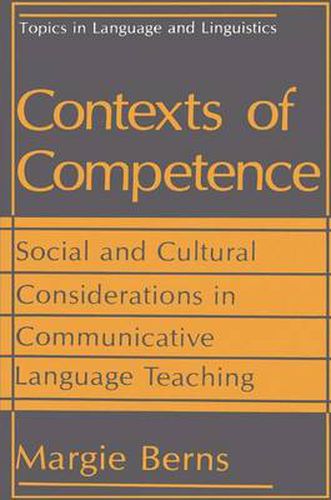Readings Newsletter
Become a Readings Member to make your shopping experience even easier.
Sign in or sign up for free!
You’re not far away from qualifying for FREE standard shipping within Australia
You’ve qualified for FREE standard shipping within Australia
The cart is loading…






This title is printed to order. This book may have been self-published. If so, we cannot guarantee the quality of the content. In the main most books will have gone through the editing process however some may not. We therefore suggest that you be aware of this before ordering this book. If in doubt check either the author or publisher’s details as we are unable to accept any returns unless they are faulty. Please contact us if you have any questions.
The introduction of communicative competence as the goal of second and for eign language teaching has led to recognition of the role of context in language learning and use. As communicative competence is defined by the social and cultural contexts in which it is used, no single communicative competence can serve as the goal and model for all learners. This recognition has had an impact on program design and materials development. One significant change is that the choice of a teaching method is no longer the primary concern. Instead, the first step for the program designer is becoming familiar with the social and cultural features of the context of the language being taught. This includes a consideration of the uses speakers make of the language, their reasons for using it, and their attitudes toward it. Contexts of Competence: Social and Cultural Considerations in Commu nicative Language Teaching explores the relationship between context and com petence from a theoretical and practical perspective. Its audience is applied linguists in general and language teaching practitioners in particular. The overall aim of its five chapters is to provide a framework for consideration of various contexts of language learning and use and to guide the implementation and development of models of communicative language teaching that are responsive to the context-specific needs of learners.
$9.00 standard shipping within Australia
FREE standard shipping within Australia for orders over $100.00
Express & International shipping calculated at checkout
This title is printed to order. This book may have been self-published. If so, we cannot guarantee the quality of the content. In the main most books will have gone through the editing process however some may not. We therefore suggest that you be aware of this before ordering this book. If in doubt check either the author or publisher’s details as we are unable to accept any returns unless they are faulty. Please contact us if you have any questions.
The introduction of communicative competence as the goal of second and for eign language teaching has led to recognition of the role of context in language learning and use. As communicative competence is defined by the social and cultural contexts in which it is used, no single communicative competence can serve as the goal and model for all learners. This recognition has had an impact on program design and materials development. One significant change is that the choice of a teaching method is no longer the primary concern. Instead, the first step for the program designer is becoming familiar with the social and cultural features of the context of the language being taught. This includes a consideration of the uses speakers make of the language, their reasons for using it, and their attitudes toward it. Contexts of Competence: Social and Cultural Considerations in Commu nicative Language Teaching explores the relationship between context and com petence from a theoretical and practical perspective. Its audience is applied linguists in general and language teaching practitioners in particular. The overall aim of its five chapters is to provide a framework for consideration of various contexts of language learning and use and to guide the implementation and development of models of communicative language teaching that are responsive to the context-specific needs of learners.